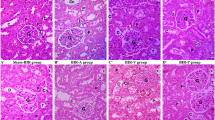Abstract
Purpose
To investigate renal ischemia injury during renal hilar clamping (artery alone versus clamping artery/vein together) by evaluating ischemic damage via two different modalities in animal models—near-infrared tissue oximetry and 8-isoprostane levels.
Methods
Near-infrared renal oximetry measurements of Yorkshire swines (n = 4; 8 renal units) subject to hilar clamping were obtained at baseline, during warm ischemia (15- and 30-min trials) and after unclamping. Quantitation of 8-isoprostane levels is the second technique of quantitating interstitial fluid collected from a dialysis catheter placed through renal parenchyma of male Sprague–Dawley rats (n = 50) subject to hilar clamping during preclamp, clamp (either 15 or 30 min of hilum clamping), and post-clamp.
Results
N ear-infrared tissue oximetry. In the 15-min trial, oxygen saturation decreased 6× faster with artery alone compared to artery/vein clamped together. In the 30-min trial, the decrease was 5× faster. Recovery of oxygen saturation with only artery clamped occurred more than 2× faster in the 15- and 30-min periods. Isoprostane. For 15-min clamp times, 8-isoprostane levels in the artery alone group demonstrated a 1.54 decrease in the artery clamped alone group (p = 0.006) versus artery/vein together: preclamp (11.47 and 11.63 pg/mL/g), clamp (14.61 and 17.70 pg/mL/g), and post-clamp (14.26 and 22.04 pg/mL/g).
Conclusions
Renal ischemia injury from clamping the renal artery alone was significantly less than clamping artery/vein together demonstrated in two different techniques. Recovery of oxygen saturation was twofold faster, and mean post-clamp 8-isoprostane levels demonstrated a 1.54-fold decrease with clamping renal artery alone compared to clamping artery/vein together.



Similar content being viewed by others
References
Pignot G, Boulière F, Patard JJ (2010) Warm ischaemia: the ultimate enemy for partial nephrectomy? Eur Urol 58(3):331–336
Secin FP (2008) Importance and limits of ischemia in renal partial surgery: experimental and clinical research. Adv Urol 2008:102461
Holzer MS, Best SL, Jackson N et al (2011) Assessment of renal oxygenation during partial nephrectomy using hyperspectral imaging. J Urol 186(2):400–404
Gong EM, Zorn KC, Orvieto MA et al (2008) Artery-only occlusion may provide superior renal preservation during laparoscopic partial nephrectomy. Urology 72(4):843–846
Orvieto MA, Zorn KC, Mendiola F et al (2007) Recovery of renal function after complete renal hilar versus artery alone clamping during open and laparoscopic surgery. J Urol 177(6):2371–2374
Schuler TD, Perks AE, Fazio LM et al (2008) Impact of arterial and arteriovenous renal clamping with and without intrarenal cooling on renal oxygenation and temperature in a porcine model. J Endourol 22(10):2367–2372
Vioptix, 47224 Mission Falls Ct Fremont, Ca 94539
Cheng X, Mao JM, Bush R et al (2003) Breast cancer detection by mapping hemoglobin concentration and oxygen saturation. Appl Opt 42(31):6412–6421
Srinivasan S, Pogue BW, Carpenter C et al (2007) Developments in quantitative oxygen-saturation imaging of breast tissue in vivo using multispectral near-infrared tomography. Antioxid Redox Signal 9(8):1143–1156
Keller A (2009) A new diagnostic algorithm for early prediction of vascular compromise in 208 microsurgical flaps using tissue oxygen saturation measurements. Ann Plast Surg 62:538
Keller A (2007) Noninvasive tissue oximetry for flap monitoring: an initial study. J Reconstr Microsurg 23:189
Cheng X, Mao JM, Xu X et al (2004) Post-occlusive reactive hyperemia in patients with peripheral vascular disease. Clin Hemorheol Microcirc 31:11
Caire AA, Alvarez X, Conley S et al (2012) Near-infrared tissue oximetry and digital image analysis: quantification of renal ischaemia in real time during partial nephrectomy. BJU Int 109(2):311–315
Wang Z, Colli JL, Lee BR et al (2012) Renal Interstitium 8-isoprostane level: a positive biomarker for renal ischemia and reperfusion injury after renal clamping in an animal model; measuring the protective effect of allopurinol using isoprostane after renal ischemia in an animal model. J Endourol 26(1):21–25
Morrow JD, Awad JA, Kato T et al (1992) Formation of novel non-cyclooxygenase-derived prostanoids (F2-isoprostanes) in carbon tetrachloride hepatotoxicity. An animal model of lipid peroxidation. J Clin Invest 90(6):2502–2507
McLoughlin GA, Heal MR, Tyrell IM (1978) An evaluation of techniques used for the production of temporary renal ischaemia. Br J Urol 50(6):371–375
Shikanov S, Lifshitz D, Chan AA et al (2010) Impact of ischemia on renal function after laparoscopic partial nephrectomy: a multicenter study. J Urol 183:1714–1718
Godoy G, Ramanathan V, Kanofsky JA et al (2009) Effect of warm ischemia time during laparoscopic partial nephrectomy on early postoperative glomerular filtration rate. J Urol 181:2438–2445
Desai MM, Gill IS, Ramani AP et al (2005) The impact of warm ischaemia on renal function after laparoscopic partial nephrectomy. BJU Int 95:377–383
Thompson RH, Frank I, Lohse CM et al (2007) The impact of ischemia time during open nephron sparing surgery on solitary kidneys: a multi-institutional study. J Urol 177(2):471–476
Go AS, Chertow GM, Fan D et al (2004) Chronic kidney disease and the risks of death, cardiovascular events, and hospitalization. N Engl J Med 351:1296–1305
Imbeault A, Pouliot F, Finley DS et al (2012) Prospective study comparing two techniques of renal clamping in laparoscopic partial nephrectomy: impact on perioperative parameters. J Endourol 26(5):509–514
Urbschat A, Obermuller N, Haferkamp A (2011) Biomarkers of kidney injury. Biomarkers 16:S22–S30
Janika M, Wasik A, Nameisnik J (2010) Isoprostanes-biomarkers of liquid peridoxation: their ability in evaluating oxidative stress and analysis. Int J Mol Sci 11:4631–4659
Conflict of interest
The authors declare that that they have no conflict of interest on this study.
Author information
Authors and Affiliations
Corresponding author
Rights and permissions
About this article
Cite this article
Colli, J.L., Wang, Z., Johnsen, N. et al. Clamping renal artery alone produces less ischemic damage compared to clamping renal artery and vein together in two animal models: near-infrared tissue oximetry and quantitation of 8-isoprostane levels. Int Urol Nephrol 45, 421–428 (2013). https://doi.org/10.1007/s11255-012-0297-7
Received:
Accepted:
Published:
Issue Date:
DOI: https://doi.org/10.1007/s11255-012-0297-7




